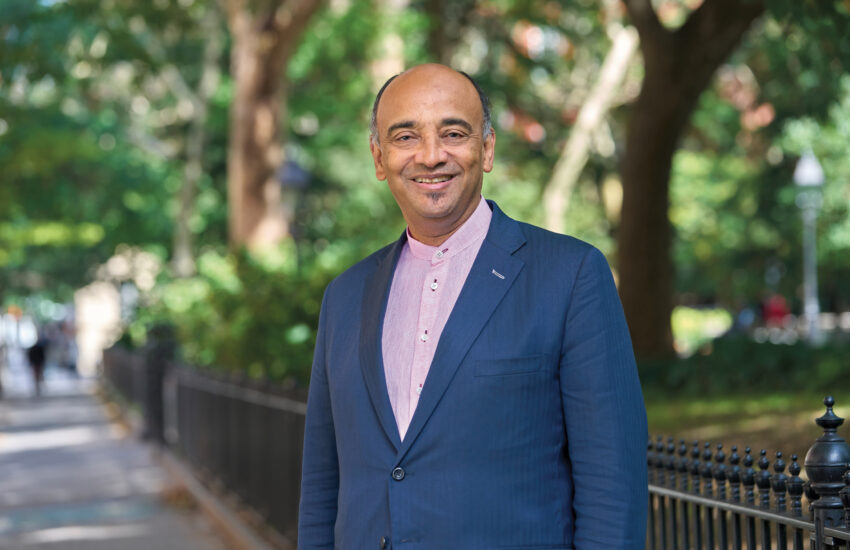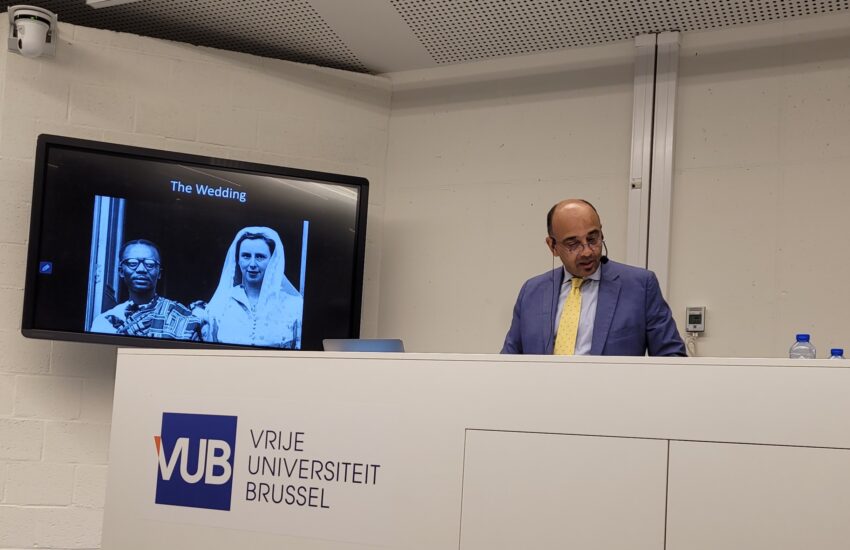Mogadishu – Lost Architecture of the Modern City
Tommy Evans is a British-born vocalist, broadcaster and postgraduate researcher. For his inaugural article for Afropean, he had the great fortune to speak to Somali-British architect Rashid Ali and British photographer Andrew Cross, the individuals behind the fantastic ‘Mogadishu – Lost Moderns’ exhibition currently on show at The Mosaic Rooms, London. Rashid’s meticulously curated black and white archival photographs of Mogadishu’s past and Andrew’s oblique images of her present left a deep impression on Tommy on account of his own family heritage and experiences traveling in the Horn of Africa.
An interview with Rashid Ali
TE: What prompted Andrew and yourself to pick Mogadishu as a starting point for the exploration of architecture?
RA: A number of reasons. I’d been researching Mogadishu pre-civil war for about three to four years. I was teaching with Andrew, so we’d have occasional conversations about doing something together because we appreciated each other’s art or approaches to architecture and research; we always thought we ought to do something together. So that was one part of the conversation on how I decided to work with jumping castle Andrew.
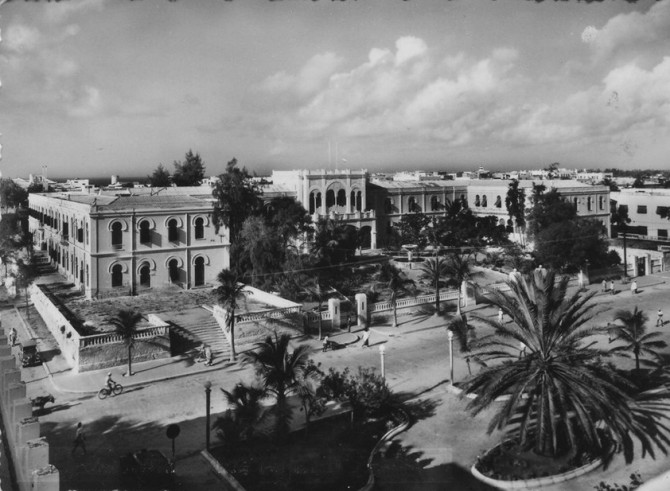
Prior to that, I studied architecture in the UK. Education, like many disciplines, is very Eurocentric or Western-centric, so everything in architecture starts with Greece, you don’t even touch Egypt, for example. Soon after graduating, I began to work with David Adjaye, the renowned Ghanaian-British architect, and after that point I became conscious of African visual references informing some of the work that we were doing. At the time, David was also traveling around a lot bringing back lots of references which began to inform the architecture we were designing, including a number of projects with artists such as Chris Ofili and so on. And David, at some point, began to do this wonderful book that was completed a few years ago called ‘Adjaye, Africa, Architecture’ whereby he actually visited every capital city in the continent – an amazing photographic survey of urban Africa looking at the different layers of the city. Finally, there were two cities left after five or six years of traveling around which were Algiers and Mogadishu. I think Algiers, with its recent political history, was complicated and Mogadishu for the obvious reasons: it was 2008, around the time of the Ethiopian invasion, a very difficult experience for the city and its inhabitants. And he said, “Rashid, could you organise for me to travel to Mogadishu?” and my response was, “David, that would be totally suicidal!” First of all, I didn’t know anyone, I didn’t have any family in Mogadishu, as I’m actually from another part of the country…
TE: Oh, really?
RA: Yes. To sum it up, we just decided to collate some archival images. I was happy to do that and wrote some text to accompany it. I was really amazed at the imagery and surprised at what a beautiful city it was, layered with social, cultural and architectural history and that’s where the journey began. I visited the British School in Rome where I had a fellowship, and I spent three months digging up material – lots of black and white archival photographs. Actually, there was hardly anything written on Mogadishu from this perspective on architecture, so really it was a visual survey to try and reconstruct this history of the city over one hundred and fifty years, at least. So at the 2012 London Festival of Architecture, The British Council were doing a section where they invited all the major embassies in the city to curate an event about their country and I approached them and said, “I’m going to be the self-appointed ambassador for Somalia; can I curate something?” And they were really very receptive. We had some meetings, I showed them some of the materials which resulted in the construction of ‘A Room for Mogadishu’ inside the Swiss Cottage Library.
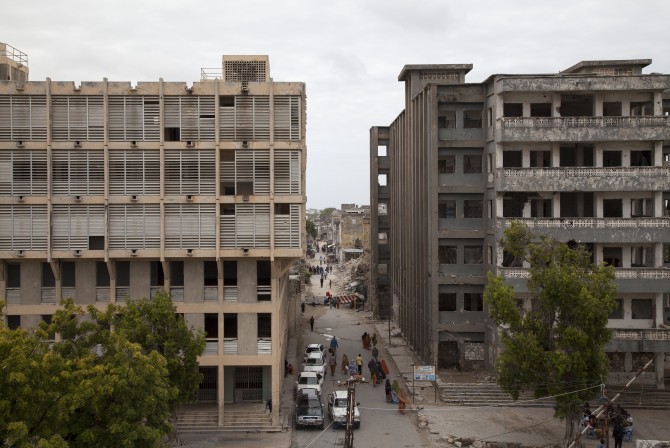
Essentially, that’s where it began. I was really interested in Mogadishu’s transformation from a traditional coastal town at the end of the nineteenth century to a period of Italian colonial planning, that’s what the early images were about. And then, the natural inclination was to record post-1960, which is this amazing period of Pan-Somali optimism where there was this collective psyche, if you like, about the future and this newfound statehood – that was when the second stage of expansion of the city of Mogadishu began to take shape. Andrew and I decided we were going to go there to see what remained of the structures that were built in the ‘60s and ‘70s and maybe also get a sense of what I call the third stage of transformation – which is the civil war, essentially.
TE: I presume you stood out as a British Somali when you were out there? So how easy was it to make those connections to gain access to the different places and buildings you visited?
RA: I did stand out. Because Mogadishu is not like Hargeisa [the capital of the self-declared state of Somaliland]. You can walk about Hargeisa without any security and it doesn’t cause a problem. In Mogadishu, it’s very different. With Andrew, for example, we only went out when we absolutely needed to and we had to have security. You’ve got to be intelligent and just integrate; not stand out in any way. I was quite conscious of this actually, as I usually have bright coloured trousers, particularly a strong royal blue that I wear often! My sister said to me, “There’s no way you are taking that with you to Mogadishu!”
In terms of getting access, a lot of public buildings are not very easy to get access to because they are really symbolic politically and are often targets for attacks. So I was incredibly lucky to get to know people that are connected to the government and security apparatus who were able to give us access and take us around. Private security is expensive for me and Andrew, who are poor academics and architects and wouldn’t be able to afford that. People looked after us because we demonstrated the value of this project.

TE: Were there any particular fond memories that stand out for you in your time there working with Andrew?
RA: One of the really fond memories wasn’t necessarily the work itself but watching the Tour De France with Andrew in Mogadishu and also watching Andrew Murray win Wimbledon. Coming from Somalia, that’s kind of weird for me – the idea of an increasingly globalised world that’s become smaller has struck me in that Somali context. Having grown up as a child, whereby your family would want to make a phone call to your relatives in the UK, they’d have to call Mogadishu then the operator would link you to Djibouti and then the one in Djibouti would finally connect you to London. So for me, it’s been that much of a gap and just to be watching SW19 live, not just myself, but hanging out with Andrew cheering on Andrew Murray was a really fun and intriguing experience.
TE: I guess you don’t get more Afropean than that – cheering Andrew Murray in Mogadishu! Was there a vision of communicating a message about Mogadishu and by extension, Somalia, to a wider audience to present a different impression to the dominant narratives?
RA: Absolutely. There are these other histories of Mogadishu that people never really get to see. Mogadishu has this period which we termed ‘Lost Moderns’, where it’s not necessarily modern but it’s contextualized locally, so it’s a local experience of a modern of some sort – we wanted to communicate that. On a symbolic level, one could say Mogadishu had a number of plans to develop the city over a period of time with lots of incredible infrastructure and buildings under the Italian colonial period; cities like New York and London didn’t have jumpers for sale city plans at the time but Mogadishu had it. Also, structures of similar architectural language were going up in the UK at the same time so it gives a sense of a particular experience or encounter with modernity that Mogadishu had and nothing’s been written about it.
TE: Are there any plans to take the exhibition to any other parts of the country?
RA: There is no point in undertaking this project if there’s no legacy – legacy meaning that you take it to Somalia because in Mogadishu there are buildings that are derelict and partially destroyed. There are adults that live in the city, approaching their mid twenties, well actually, probably even older than that who have never known some of those really ‘modern’ buildings in any other state, so that gives you some sense of how very little is known by the Somalis themselves – most of whom are young – about the history of their city. We definitely want to take it out. We’re going to Dakar next and the aim ultimately, next year or the year after, is to take it to Mogadishu and to create an archive of some kind.
An interview with Andrew Cross
AC: I think it was very important that Mogadishu was seen through the eyes of somebody from Europe but not with the intention of replicating the whole ‘Black Hawk Down’ thing. And one of the things that has been most delightful for me is meeting members of the Somali community in London who have confirmed that, they’ve seemed to be delighted that somebody has given an impression of the city which is very different from what they normally have to deal with.
TE: A counter-narrative, I guess.
AC: The nature of photography is complex and if somebody else had gone with the same agenda, it would have been different to how I would have done it. I don’t do clean-lined, straight on elevations the way that an architectural photographer might – I’ve taken an oblique view. I kind of glanced past the buildings slightly. I’m not always looking directly at it but through it and past it so that’s how buildings are lost in experience. Of course, it’s ‘bleak’ because they’re stripped back but not bleak because there’s been violence and conflict – I like to think they speak of potential. They’re certainly empty – like the National Assembly building and the theatre – because they’re closed off to the public so there aren’t that many people there. But particularly if you look at the video and some of the other images that I did take, you see a very different thing.

TE: The video catches the ‘busyness’ of the city and it’s very different to the photography – it’s a nice balance actually.
AC: Well, thank you, and I hope so. That was quite casual: I shot a lot of it outside my hotel window, put the camera up and let it roll. I wasn’t looking for anything particular. Life goes on. It’s fairly chaotic but you wouldn’t think it’s a failed state.
TE: How did your creative relationship with Rashid work?
AC: It would have been impossible for someone like me to do something independently. Let’s face it, it involved him having certain connections which facilitated opportunities because it’s complex and there’s a level of cultural things that I certainly wouldn’t have been able to navigate. We didn’t necessarily sit down and go, “Look, I want to do this”, “No, you should do that..” We both knew that we had a shared sensibility, so I don’t think there was any concern that we would be doing something we might disagree with. We might have had our little tantrums… We were like a couple of old women sometimes! But that’s what makes it really free and nice.
TE: Did you set out with an agenda, or was it a just a case of wandering about?
AC: There was an agenda in terms of particular locations but Rashid did the research. Once we were there opportunities presented themselves. We were in an area outside what is officially the national bank and this guy came over curious to see what we were doing. And like many others like him, this guy was young, had been part of the diaspora in London, trained in banking, and like many of the middle class professionals had gone back to work there. This guy invited us up onto the roof and for that we were able to get those great high-level views. That was unexpected! Often, it would be touch and go for whatever reason. The National Assembly is where the parliament is and you can imagine security is a big issue, if they’re slightly nervous about something it’s suddenly – “You can’t do it!” We did visit the Presidential Palace, a great, wonderful 1930s Art Deco building which was the Italian governor’s residence. The president had been ill and was working from home so of course, we couldn’t go because he was there, but the very last afternoon on the very last day, he decided he was OK and went somewhere else – so we could go there. So that was very last minute and a very special moment.
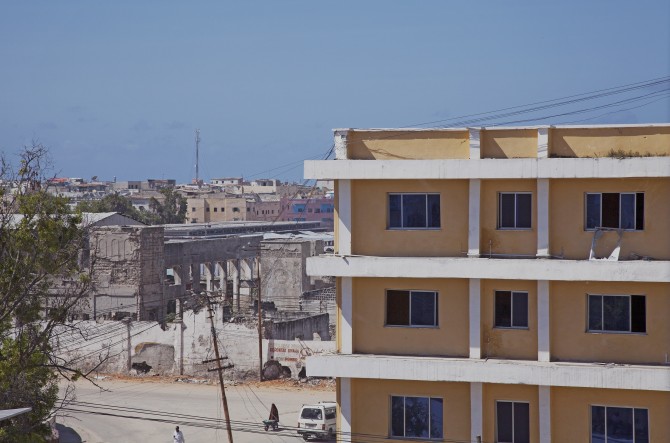
TE: How do you feel this project links aesthetically to your earlier work?
AC: Again, it’s just that… oblique view. This is something I got from the great writer Geoff Dyer who has a book about photography. You look at things, things that interest you, things you want to photograph and you distill that. I came to this conclusion that what I’m interested in is photographing around corners.
TE: Really?
AC: So literally – in the case of roads, journeys, railway lines and what have you – but also metaphorically. Figuratively, you picture something: but the way I do, you’re very aware there’s something off the frame. I don’t try and encapsulate everything within the frame’s view; there’s a sense you could walk further round and find something. In many ways, life is like that, or certainly, the way we experience architecture – we’re always aware that there’s something on the other side of that wall or around the comer. I was not sure myself what the relationship was but the more I reflect upon it the more I think there’s quite a lot that ties it together. Plus the whole interest in the nature of architecture, looking at the past and the present and what that might mean for the future is something that interests me. Quite a lot of what I do is a reflection upon the past: OK, this wasn’t my past, it was Rashid’s past, but I think the principle is the same.
TE: Any particularly memorable experiences or stories while you were capturing that reality out there?
AC: The question that everybody asks about the place… I don’t think I ever felt in danger. OK, I had security, but I don’t think I ever sensed any atmosphere of violence amongst people or the sense there was a threat coming from somewhere else. The way people drive there is absolutely mechanical bull for sale crazy and all the cars are beat up. There was a moment when someone went slightly into the back of somebody else. [But] there were no people shooting each other which, again, “Black Hawk Down” gives the impression there’s this lawlessness, guns and what have you, but it’s not like that.
TE: It can become a caricature…
AC: Of course. It was stressful but for other reasons. We could only work two or three hours a day because of limitations of access, limitations of security, after two or three hours I couldn’t do any more because it was so hot. So chilling out in the hotel where, thanks to the wonderful Al Jazeera, I could watch the Tour de France live. That highlights that thing where you go somewhere very different and very new and so there are those amazing contrasts but there are – not just watching the TV in the hotel – other things that make it incredibly familiar.
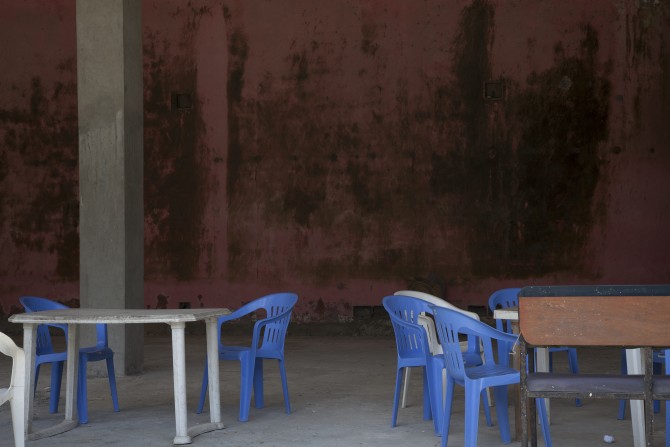
TE: Do you ever want to go back?
AC: Yeah course I do! The interesting thing for me, to be honest, is wherever I go – I travel a lot – I always know how to get to the airport. And this was the first time I was entirely dependent upon other people getting me to the airport and of course, they were wonderful, they were amazing, they were so hospitable and yet it wasn’t until I actually got on the plane I was like, “Hold on, that was fine – why am I going home?”
Mogadishu – Lost Moderns is exhibiting at The Mosaic Rooms until 26 April 2014. A.M. Qattan Foundation, Tower House, 226 Cromwell Road, London SW5 0SW
Exhibition open Tuesday-Saturday, 11am-6pm. Entrance free. Visit www.mosaicrooms.org

